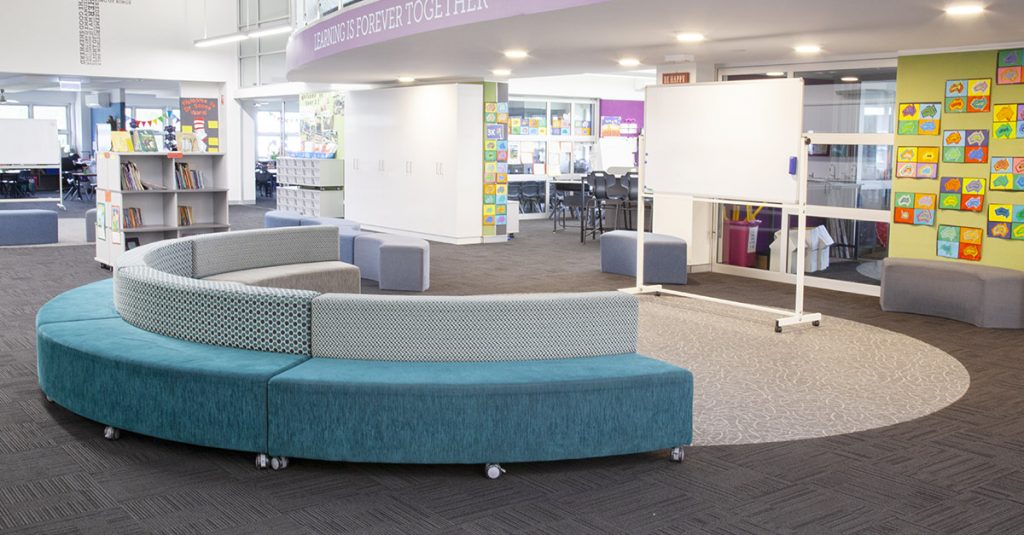The physical learning environment has a powerful impact on students’ social and emotional landscape.
Physical spaces should be intentionally designed to support academic achievement. Though educators and designers have a variety of frameworks available to guide their development of 21st century learning spaces, the works of futurist David Thornburg and his primordial archetypes are heralded by many. Learn more about how you might use his imagery can shape classroom space into engaging, powerful learning environments.
Why Learning Spaces Need to Be Re-Imagined
The traditional linear, boxed layout of the classroom no longer suits the needs of today’s learners. Information technology has fundamentally changed how students today interact with information, their world, and each other. The world itself has evolved, and the skills and knowledge needed have similarly shifted.
A 21st century classroom design facilitates several types of learning and accommodates various types of learners. A 21st century learning space has several key elements, including:
· Adaptable layout
· Flexible seating
· Areas suited to specific tasks
· A small teacher work area
· Resources that are easily accessible to students
· Available technology.
The Campfire:
The Place for Direct Instruction
Since primordial times, people have gathered to hear wisdom of experts. For Thornburg, the image of the campfire embodies this transfer of knowledge. People gathered around campfires to hear stories from the storytellers, the keepers of community wisdom.
Modern classrooms have replaced the fire with projectors and whiteboards. The traditional classroom relies heavily on lecture space, where students listen to instruction from the teacher. Many learn from the one.
Direct instruction certainly has a place in modern teaching environments, but it should be only one mode of learning.

The campfire space in the classroom might feature a lecture podium facing rows of seats or benches. Additional seating options might be present to better accommodate different students; for example, energetic children with difficulty sitting still for the length of a lecture might benefit from an exercise ball to sit upon or similar chair that allows the child to sustain attention while still moving physically. The campfire should provide display space for presentation materials.
The Watering Hole:
Spaces for Social Learning
The watering hole represents conversational space. Thousands of years ago, people would meet informally around the watering hole, sharing information with each other. Today, in offices people gather around the water cooler. Conversations with others is a form of social learning. 21st century learning spaces should provide places for peer-to-peer learning and small group discussions.
In the classroom, the watering hole space might have several small tables around which a few students can work together. A watering hole might take the form of a cluster of cushions and bean bags in a nook of the room.
At its most simple, the social learning space could be chairs carried over from the lecture space.

The Cave:
The Home for Reflective Learning
The campfire brings students into contact with an expert, and the watering hole brings contact with other students. The cave brings students into contact with themselves. The cave is a space to reflect, where the student incorporates external information into internal understanding. Thinking and reflecting are important parts of learning, and students need space to sit quietly alone at times.
Caves come in many shapes and sizes. Classrooms might have students create their own cave by moving a chair off by itself and using headphones. Soft seating can be used for independent time, as can a cushion in a corner.

Life:
Where Theory Meets Practice
In life, learners apply the insights gained from lectures, dialogue, and self-reflection. Life is the practical application of what is learned. Students benefit from space for experiential learning, where they can try out the things just learned. Students’ learning is reinforced when they can see the real-world application of theories.
Makerspaces are places for tinkering and trying out new things. A hands-on area might include standing-height tables and furnishings with adjustable surfaces. Furniture with built-in power sources facilitate the use of equipment or technology resources.

Ways You Can Change Your Classroom
Ideally, the 21st century learning space incorporates all of Thornburg’s primordial learning spaces. In large enough classrooms, each of the archetypal areas could occupy its own place, and students could flow from one form of learning to another throughout the day.
A group of learners should be able to move from the campfire (listening to one speaker in a traditional lecture) to the watering hole (collaborating in group discussion or working on team or project-based activities) to the cave (working independently on reading, writing, or accessing computer resources) to life (tinkering on projects in a makerspace or publishing a blog).
To accommodate the flow of activities, it makes sense to construct spaces that are capable of quick reconfiguration to support the different kinds of activity.

Outfitting the classroom with flexible furnishings, such as moveable tables and chairs, for example, allow for the rearrangement of space to fit the task. Rows of seating are appropriate for teacher instruction and lecture. These can then be moved together along with small tables to form clusters where students can gather in groups of three or four to discuss what was just learned or to work on group projects. Individual seats can be relocated to nooks and crannies to help create individual learning spaces.
Modular designs of self-contained, individual learning spaces can replicate the cave concept. Furnishings with a seat, desk space, power outlet, and some form of barrier help focus the student to work independently.
Physical places influence mental spaces in many ways. One of those ways is learning. The environment can encourage and reinforce different forms of learning. Creative use of adaptable spaces and flexible furnishings can be used to promote the learning styles represented by Thornburg’s primordial metaphors.
Sources:
Thornburg, David D. “Campfires in Cyberspace: Primordial Metaphors for Learning in the 21st Century.” October 2007, Thornburg Center for Professional Development, epubgeneration.pbworks.com/f/campfires.pdf?ld=1.
Van Note Chism, Nancy. “Challenging Traditional Assumptions and Rethinking Learning Spaces.” Learning Spaces, www.educause.edu/ir/library/pdf/pub7102.Pdf.
Davis, Ann W.; Kappler-Hewitt, Kim. “Australia’s Campfires, Caves, and Watering Holes.” June/July 2013, Learning & Leading With Technology, files.eric.ed.gov/fulltext/EJ1015175.pdf.











